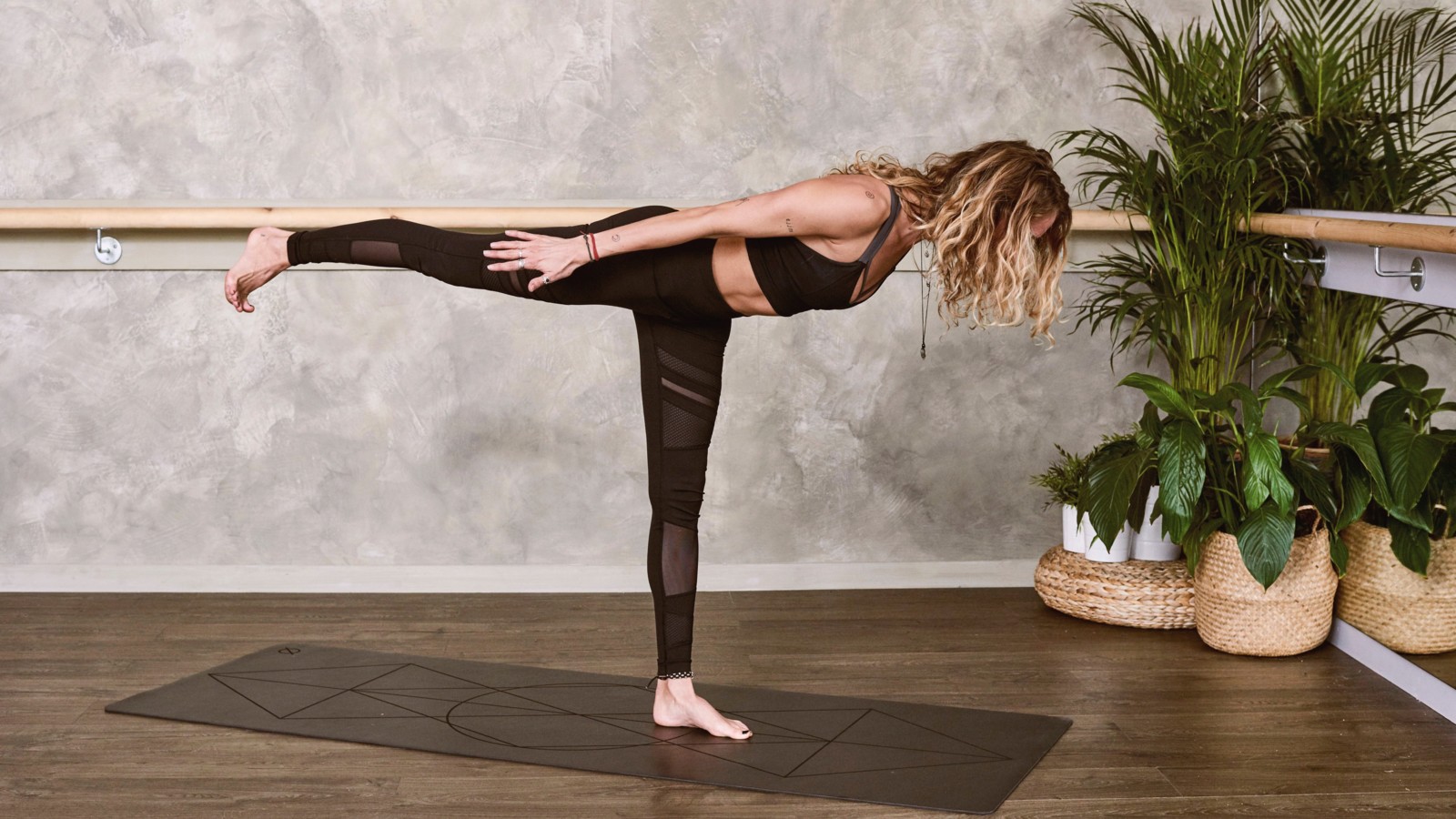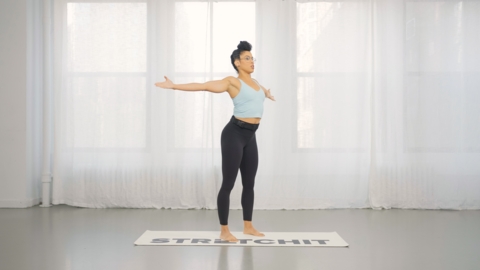How to Handle Hamstring Injuries
Bummer. Here’s what to do if you’re dealing with a hamstring injury.
Hamstring injuries are no joke. They can affect people across all kinds of sports and can be such a pain in the butt (literally), demanding a slow healing process with persistent symptoms. The good news is that just because you have a hamstring injury doesn’t mean you have to give up on your #goals.
In this article, we’ll walk you through strategies for dealing with a hurt hamstring, and how you can stay active (and bendy) if it’s a mild strain.

Understand the Injury
Along the back of your leg, the hamstrings are a group of three muscles that run from the sit bone to the knee. The hamstrings help you extend your leg behind your body (in a standing split your hamstrings lift the top leg). They also bend your knee. A hamstring injury happens when you strain or pull one of these three muscles. The injury can be a mild muscle pull/strain, a partial muscle tear, or a complete muscle tear1.
The first thing you’ll need to do is assess your injury to determine whether it’s a mild strain (best case scenario) or if it’s more serious. Whichever one it is, don’t panic. There are many ways forward that can be positive and that can help you heal and learn from the experience. The number one thing to keep in mind? Don’t let your ego get in the way, forcing a hurt hamstring into positions that will only make things worse just because you’re eager to return to training-as-usual. Kindly ask your ego to step aside as you tune into what your body truly needs.
Sometimes the hamstring injury will be a tweak from overdoing it. You may feel discomfort, sensitivity, or it might be tighter than normal. That’s likely a strain. When it's a partial or full tear, the symptoms can include:
- Sharp pain in the back of your thigh
- A “popping” or tearing sensation
- Swelling or tenderness immediately after the injury
- Bruising or discoloration along the back of the leg
- Pain in the range of motion
In severe cases where you can’t put any weight on the leg, you should see a doctor immediately. The most intense cases of hamstring injury may require surgery to reattach the torn muscle, but those are usually when the hamstring has been under an incredible load like from sprinting on a track, skiing down an alpine slope, or engaging in another kind of intense activity where there are sudden stops.
If your injury is causing more than just mild discomfort, if it’s getting worse, or if it’s simply not healing, it’s important to see your doctor. Your doctor can help make a proper assessment of the injury and will be able to recommend you to a physical therapist.
With mild hamstring strains, you can generally take care of them through home treatment, which involves protecting the healing tissue and making your full recovery a priority.
"Even if you have setbacks and you have bad days, you have to believe in yourself that things are going to turn around...that's the process, and you just have to be patient and not give up hope and believe in yourself. Things will turn the corner."

Make Recovery a Priority
It’s best to fully embrace the fact that your hamstring injury may take a while to heal. It can be weeks or months before it’s feeling back to normal.
When the injury first happens, many doctors recommend the RICE method to reduce swelling and inflammation:
- Rest.
- Ice. Apply cold packs for 20 mins, several times a day.
- Compression. Wear compression tights or compression bandage to reduce the swelling.
- Elevation. Get your leg higher than your heart while resting.
It’s also common for doctors to recommend over-the-counter pain medications such as ibuprofen or acetaminophen, which help manage any pain and reduce inflammation2.
And while RICE is recommended right when the injury happens, there are a lot of different thoughts (ex. Eastern vs. Western medicine methodologies) about proper care for the hamstring moving forward. These methods of recovery can include gentle foam-rolling, Epsom salt baths, massage, and acupuncture. Getting blood circulating to the injury site improves healing, so as the healing progresses past the initial onset you may want to try these methods. The closer the injury is to the attachment site (at the sit bone usually) the less blood flow there is and the longer the healing process takes, so these methods can help you get circulation to the areas that need it most.
Sometimes it’s easy to shrug off the discomfort of a hamstring strain, ignore it, and keep pushing through your workouts. When you do this, you might feel like you’re winning—but it’ll be short-lived. When you continue to repeat movement patterns that likely led to your injury in the first place, you’re setting yourself up for more a serious injury down the road. Regaining your full, pain-free range of motion is the goal. Make healing a priority.

Protect the Healing Tissue
When you’re nursing a hamstring injury, it’s important not to aggravate the injured muscle. If it’s a partial or full tear, you’ll need to work with your doctor and physical therapist for an appropriate recovery plan and get their approval on movements that are okay to train. If you have a strain, here are some things you can continue to work on while protecting the healing tissue.
Try to focus on a goal that strengthens the hamstrings without compromising the healing process, such as working on backbends. Backbends are a great choice because you can target the upper, mid, and lower back and shoulders, while also opening the hip flexors and strengthening (rather than stretching) the hamstrings. Bridge and wheel pose are both natural hamstring strengtheners. In these movements, you’re recruiting the strength of your hamstrings and glutes to open the hips.

If it’s your splits you’ve concerned about, there are a few things you can focus on that will help prepare your body for improved splits once the strain has healed. Focus your attention on:
- hip flexor stretches
- quad stretches
- hip stretches
- hamstring exercises to build strength and stability
Hip stretches like pigeon pose, double pigeon, supine pigeon, cow-faced pose, and lizard are all hip openers that feel amazing and are usually safe to work on when you’re nursing a hamstring strain. If you feel any sharp pain, make sure not to push through the pose and make a mental note that it’s probably best to skip that exercise.
Hip flexor stretches like lunge variations as well as quad stretches (like bringing your back heel to the butt in a low lunge) are another great focus for improving your splits.
Hamstring activations like bridges, single-leg deadlifts, and arch holds can also be great exercises to help you rehabilitate the hamstring while building up your strength and stability. You may have noticed that your STRETCHIT classes lead you through a lot of these exact exercises ☺.
Of course, every injury is different and every body is different, so these are just general guidelines! Your healing process won’t be the same as anyone else’s, and the best way to understand exactly what’s right for your rehab is to work with a professional. Let them know about your flexibility goals and ask them what exercises you can do to get back to your training as quickly and as safely as possible.

Make Changes to Prevent Future Injury
One of the most important steps to take after a hamstring injury is to learn from the experience and—with that experience in hand—make changes to your training routine so you can prevent re-injury.
Ask yourself if any of the reasons below were the cause of your hamstring strain in the first place. The following risk factors are common causes of injury:
- Muscular imbalance
- Improper alignment and/or repetitive poor form
- Lack of proper physical preparations/warm-up (i.e.—doing too much too soon *this is especially important when taking social media photos...don’t compromise your hamstrings for a split picture! Make sure you’re warm/prepared to do it)
- Instability in the joints
- Lack of strength
- Overtraining
Be honest with yourself and reflect on how you can address the root cause of your injury, not just the symptoms. You may need to schedule more rest days in-between the days you're training intensely. Or, you may need to add a pilates class to your weekly workout routine so that you can improve your core strength and stability. Make a concrete plan to address the root cause of the injury, and if you’re not sure what the root cause is, visit a local physical therapist for a thorough assessment. The physical therapist can help you understand your body mechanics and what you need to work on (and we all have something we need to work on!).
"You have the power to heal your life, and you need to know that. We think so often that we are helpless, but we’re not. We always have the power of our minds...Claim and consciously use your power."

Be Kind to Yourself
In the end, it’s super important to be kind to yourself throughout the healing process. Listen to what you’re saying to your body. The energy that you direct towards yourself matters. We can either encourage our healing process by being thoughtful and kind to ourselves, or we can hinder the process through self-deprecation. It’s a choice, and when you change your mindset you change the whole process. Even though you’re injured doesn’t mean you aren’t worthy, hard-working, and wonderful! Remember that.
Your injury is one step along your training journey. You are not alone—many others have dealt with injuries like yours and have been successful in their recovery. Use your struggle as your strength. You can learn a lot from your injury and integrate changes to your training that will make you a better flexibility student and help you take a more balanced and safe approach to your training.
“When you can’t control what’s happening, challenge yourself to control the way you respond to what’s happening. That’s where your power is.”

1 Hamstring injury. NHS Choices. https://www.nhs.uk/conditions/hamstring-injury/. Published July 30, 2018. Accessed March 1, 2019.
2 Hamstring Injury.” Mayo Clinic, Mayo Foundation for Medical Education and Research, 28 Sept. 2018., www.mayoclinic.org/diseases-conditions/hamstring-injury/diagnosis-treatment/drc-20372990




